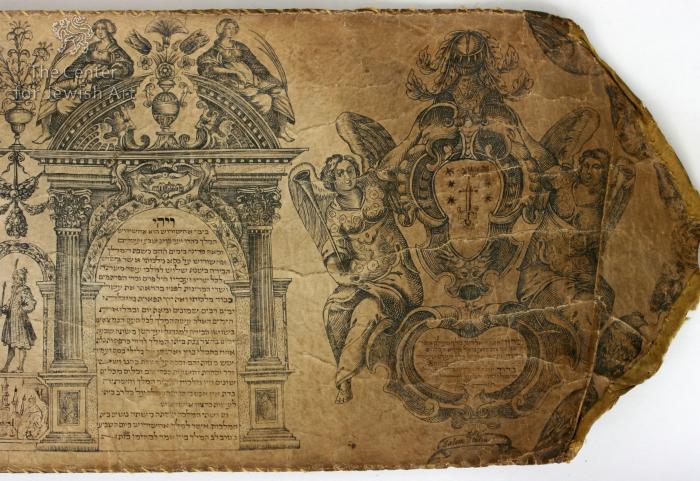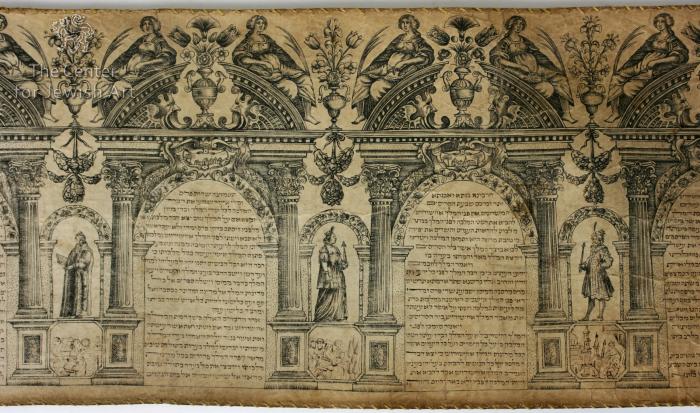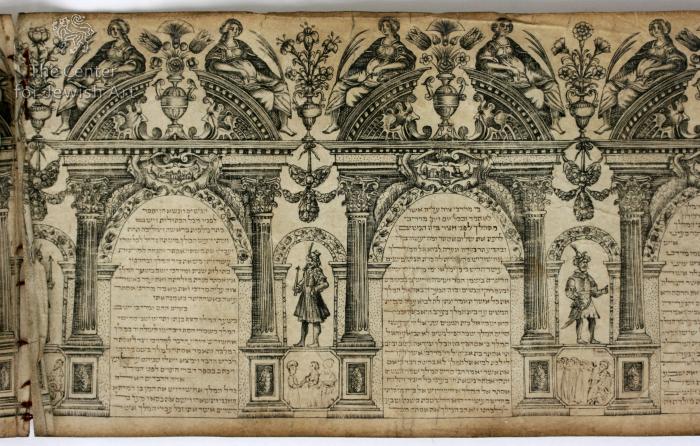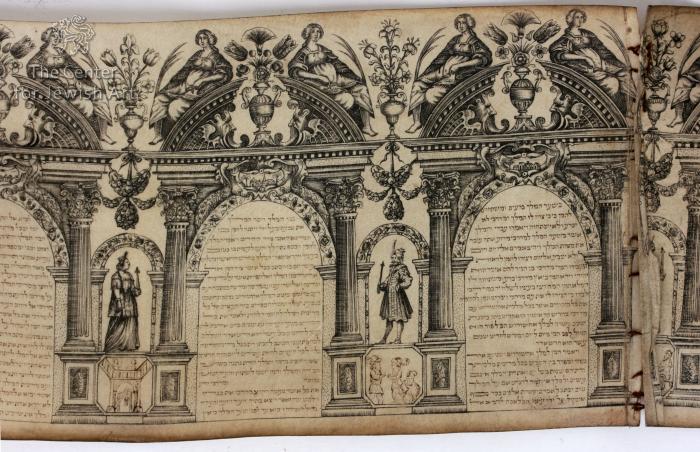Obj. ID: 39609 GFC Shalom Italia Engraved Esther Scroll with Hand-Drawn Illustrations, Amsterdam, 1640s

In general, the manuscript (the text, decorations, and parchments) is well preserved.
The silk is dirty.
Lavishly decorated Esther scroll adorned with an engraved border designed by Shalom ben Mordecai Italia (also known as Shalom D'Italia).
The scroll opens with a symmetrical decoration composed of six birds and a prefatory panel with two angels and cartouches. In the upper cartouche, a coat of arms is drawn, while in the lower cartouche, the initial benedictions are written. Below it, on the ribbon, the name of the artist is printed.
The Hebrew text of the Book of Esther is inscribed within elaborately decorated arcades on which ornamentation of the upper margins is placed. They are filled with repetitive elements: two women with their heads turned away from one another, holding palm branches and leaning on broken pediments (possibly an allegory of Peace) and flower-filled vases placed inside the pediments (they are flanked by decorative masks) and separating the pairs of women. In the elongated cartouches placed at the top of the arches, various land- and cityscapes are included. Full figures of four Esther story protagonists - Ahasuerus, Esther, Mordecai, and Haman - are placed in the niches between the text panels. They stand on small octagonal pedestals on which narrative scenes from the Book of Esther are drawn in pen and ink (in all other copies - see "Related objects" - they are filled with eight different land- and seascapes). The same engraved metal plate was used for all membranes; therefore, the decorative scheme repeats along with the entire length of the scroll, except for illustrations.
Underneath the opening section of the scroll, a piece of silk fabric is stitched. The scroll is mounted on the roller but it is not stitched to it.
The Book of Esther in Hebrew preceded by the initial benedictions.
The scroll is formed of 4 sheets. The first 3 sheets contain in total 22 columns with the text of the Book of Esther and the two additional panels are written on the fourth sheet. Each column includes 21 lines, except for col. 19 which has 19 lines, col. 20 which has 11 lines divided into two half-columns, and col. 22 with 23 lines (the last two words of the book are written on the lower margin).
The number of columns of text per sheet: nos. 1 - 6 columns, nos. 2 and 3 - 8 columns, no. 4 - 2 columns.
The text is written in Hebrew square script in brown ink of different shades on the flesh side of parchment membranes.
The letters ח (Es. 1:6) and ת (Es. 9:29) are enlarged and bolded. Other enlarged and diminished letters are included in col. 20.
The text opens with an enlarged word ויהי written separately in the first line.
The name of Harbona in col. 14 starts with an enlarged letter ח that is formed of two parts joined with a roof.
The ruling is barely visible and only in a few places.
The pricking is invisible.
The membranes of the scroll are stitched together.
Within the last arcade (no. 22 on the fourth membrane), a short inscription by the scribe Moses Gabay in Portuguese is written: "Mosse gabay escreueo esta migila [two illegible words] 1470 [or 1670]".
It seems the illustrations were drawn with the same ink as the text was copied.
Some details on the third membrane are colored with orange paint.
The text in col. 20 is written in darker ink.
There are several scrolls sharing the same pattern and others adorned with different borders designed by the same artist (see "Related objects").
Bibliography concerning the scrolls designed by Shalom Italia or attributed to him:
Sharon Assaf, Emily D. Bilski, Salom Italia's Esther Scrolls and the Dutch Golden Age, Amsterdam 2011.
A Journey through Jewish Worlds: Highlights from the Braginsky Collection of Hebrew Manuscripts and Printed Books, eds. E.M. Cohen, E. Schrijver, S. Liberman Mintz, Amsterdam 2009, 228-231 (describes another scroll designed by Shalom Italia).
Michael Garel, An Esther Scroll by Shalom Italia, "The Israel Museum Journal" 5 (Spring 1986), 107–108.
Mordecai Narkiss, Yeẓurato shel Shalom ben rabbi Mordechai Italia (1619–1655?) [The Oeuvre of the Jewish Engraver Salom Italia (1619–1655?)], "Tarbiz" 25(4), 1956, 441–451, and: ibidem no. 26(1), 1957, 87–101.
Shalom Sabar, A New Discovery: The Earliest Illustrated Esther Scroll by Shalom Italia, „Ars Judaica” 2012, no. 8, 119–136.
Schöne Seiten. Jüdische Schriftkultur aus der Braginsky Collection, eds. Emile Schrijver, Falk Wiesemann, Evelyn M. Cohen, Sharon Liberman Mintz, Menahem Schmeltzer, Zurich 2011, 274‒279.















